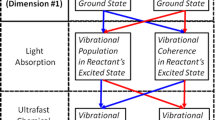Abstract
AN important objective of theoretical photochemistry is to describe the interplay between the different decay channels of molecules in electronic excited states1,2. Detailed information on the potential energy hypersurface is required to specify the molecular dynamics in terms of saddlepoints and activation energies along the reaction coordinate. Excited electronic states differ from the ground state because of the changes in the electronic distribution within the molecular framework. These changes are accompanied by changes in bond orders, force constants of vibration and dissociation energies. Vibrational spectra of excited states could be expected to provide important information on changes in frequencies of particular normal modes relative to those of the ground state molecule. Triplet excited states in solution have been studied by many techniques, the most common being flash photolysis in combination with optical absorption spectroscopy. Vibrational spectroscopy has to our knowledge only been reported in a single case, where one vibrational band of the lowest state of deuterated naphthalene generated by steady-state illumination was detected by infrared spectroscopy3. Recently, resonance Raman spectroscopy has been established as a powerful technique for studying shortlived species in solution4. This technique combines high sensitivity and time resolution with selectivity and structural information. It has been used successfully to study free radicals in solution generated by stopped flow methods5, electrochemically6, by pulse radiolysis4 and recently by laser flash photolysis7. Here we make the first report on the resonance Raman spectrum of a molecule in its triplet state generated by pulse radiolysis.
Similar content being viewed by others
References
Rice, A. A. & Gelbart, W. M. Pure appl. Chem. 27, 361–387 (1971).
Henry, B. R. & Siebrand, W. in Organic Molecular Photophysics (ed. Birks, J. B.) Vol. 1, 153–237 (Wiley, London, 1973).
Clarke, R. H., Kosen, P. A., Lowe, M. A., Mann, R. H. & Mushlin, R. JCS Chem. Commun. 528–529 (1973).
Wilbrandt, R., Pagsberg, P., Hansen, K. B. & Weisberg, K. V. Chem. Phys. Lett. 36, 76–78 (1975); Pagsberg, P., Wilbrandt, R., Hansen, K. B. & Weisberg, K. V. Chem. Phys. Lett. 39, 538–541 (1976).
Ernstbrunner, E. E., Girling, R. B., Grossman, W. E. L. & Hester, R. E. JCS Faraday Trans. II 74, 501–508 (1978); JCS Perkin Trans. II 177–184 (1978).
Jeanmaire, D. L. & van Duyne, R. P. J. Am. chem. Soc. 98, 4034–4039 (1976).
Atkinson, G. H., Srivastrara, R. B. & Dosser, L. R. Science (in the press).
Cooper, R. & Thomas, J. K. J. chem. Phys. 48, 5097–5102 (1968).
Bensasson, R. & Land, E. J. Trans. Faraday Soc. 67, 1904–1915 (1971).
Zerbi, G. & Sandroni, S. Spectrochim. Acta 24 A, 483–510, 511–528 (1968).
Spiro, T. G. & Stein, P. A. Rev. phys. Chem. 28, 501–521 (1977).
Orloff, M. K. & Brinen, J. S. J. chem. Phys. 47, 3999–4001 (1967).
Wagner, P. J. J. Am. chem. Soc. 89, 2820–2825 (1967).
Author information
Authors and Affiliations
Rights and permissions
About this article
Cite this article
WILBRANDT, R., JENSEN, N., PAGSBERG, P. et al. Triplet state resonance Raman spectroscopy. Nature 276, 167–168 (1978). https://doi.org/10.1038/276167a0
Received:
Accepted:
Issue Date:
DOI: https://doi.org/10.1038/276167a0
- Springer Nature Limited
This article is cited by
-
Vibronic spectra and intensities in Raman scattering spectra of complex molecules (review)
Journal of Applied Spectroscopy (1986)
-
Low-frequency resonance Raman spectroscopy of the deoxyhaemoglobin transient of photolysed carboxyhaemoglobin
Nature (1981)
-
Modern equipment and procedures for the investigation of spontaneous Raman scattering spectra (Review)
Journal of Applied Spectroscopy (1981)





